
Pool of Radiance is a role-playing video game developed and published by Strategic Simulations, Inc (SSI) in 1988. It was the first adaptation of TSR's Advanced Dungeons & Dragons (AD&D) fantasy role-playing game for home computers, becoming the first episode in a four-part series of D&D computer adventure games. The other games in the "Gold Box" series used the game engine pioneered in Pool of Radiance, as did later D&D titles such as the Neverwinter Nights online game. Pool of Radiance takes place in the Forgotten Realms fantasy setting, with the action centered in and around the port city of Phlan.

Adventure is a video game developed by Warren Robinett for the Atari Video Computer System and released in 1980 by Atari, Inc. The player controls a square avatar whose quest is to explore an open-ended environment to find a magical chalice and return it to the golden castle. The game world is populated by roaming enemies: three dragons that can eat the avatar and a bat that randomly steals and hides items around the game world. Adventure introduced new elements to console games, including enemies that continue to move when offscreen.

Cliff Bleszinski, popularly known as CliffyB, is an American video game designer, known for his work on the Unreal and Gears of War series while at Epic Games. After leaving Epic in 2012, he co-founded Boss Key Productions in 2014 which closed in 2018 after the commercial failure of the multiplayer shooter LawBreakers. Since Boss Key's closure, Bleszinski has spent his time with theater and writing.

Eric the Unready is an adventure game developed and published by Legend Entertainment for MS-DOS in 1993. Eric the Unready is a parody of the fantasy genre in general, though it parodies numerous other topics as well, ranging from Star Trek to Zork. It tells a comedic story of the titular unqualified knight on a quest to rescue a princess. The game also adapts the character Morgan le Fay from Arthurian legend. The game was well received.

Ravenloft is an adventure module for the Dungeons & Dragons (D&D) fantasy role-playing game. The American game publishing company TSR, Inc. released it as a standalone adventure booklet in 1983 for use with the first edition Advanced Dungeons & Dragons game. It was written by Tracy and Laura Hickman, and includes art by Clyde Caldwell with maps by David Sutherland III. The plot of Ravenloft focuses on the villain Strahd von Zarovich, a vampire who pines for his lost love. Various story elements, including Strahd's motivation and the locations of magical weapons, are randomly determined by drawing cards. The player characters attempt to defeat Strahd and, if successful, the adventure ends.
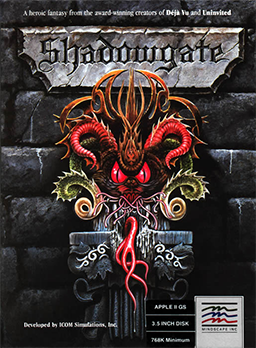
Shadowgate is a black-and-white point-and-click adventure game published for the Macintosh as part of the MacVenture series. The game is named for its setting, Castle Shadowgate, residence of the evil Warlock Lord. The player, as the "last of a great line of hero-kings" is charged with the task of saving the world by defeating the Warlock Lord, who is attempting to summon up the demon Behemoth out of Hell. Later that year, a color version of the game was released for the Amiga and Atari ST, and in 1989 for the Nintendo Entertainment System.

The Black Cauldron is an adventure game designed by Al Lowe of Sierra On-Line and published in 1986. The game is based on the Disney film The Black Cauldron, which was itself based on the Chronicles of Prydain novel of the same name by Lloyd Alexander. It was made shortly after the first King's Quest game, so it resembles that game in many ways. Along with The Dark Crystal it remains one of only a few adventure games by Sierra to be based on films.

Wizards & Warriors, titled Densetsu no Kishi Elrond in Japan, is an action platform video game developed by Rare and published by Acclaim Entertainment for the Nintendo Entertainment System. It was released in North America in December 1987, and in Europe on January 7, 1990. The player controls Kuros, "Knight Warrior of the Books of Excalibur", as he sets out in the Kingdom of Elrond to defeat the evil wizard Malkil. Malkil holds the princess of Elrond captive in Castle IronSpire, deep within the forests of Elrond. The player fights through forests, tunnels, and caves, while collecting keys, treasure, weapons, and magic items.

Uninvited is a black-and-white horror-themed point-and-click adventure game. It was originally developed for the Macintosh by ICOM Simulations released in 1986 by Mindscape as part of the MacVenture series.
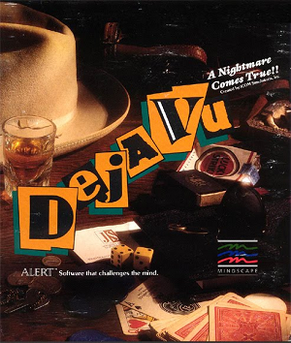
Déjà Vu is a point-and-click adventure game set in the world of 1940s hardboiled detective novels and films. It was released in 1985 for Macintosh – the first in the MacVenture series – and later ported to several other systems, including the Amiga. Initially, the game featured black and white graphics, and later releases introduced color.

King's Quest V: Absence Makes the Heart Go Yonder! is a 1990 graphic adventure game by Sierra On-Line. Originally released in November 1990, it featured a significant improvement in graphics. It was also the first King's Quest installment to replace the typing user interface with a point-and-click user interface. The title is a spoof on the proverb "Absence makes the heart grow fonder".

Secret of the Silver Blades is the third in a four-part series of Forgotten Realms Dungeons & Dragons "Gold Box" adventure role-playing video games. The game was released in 1990.
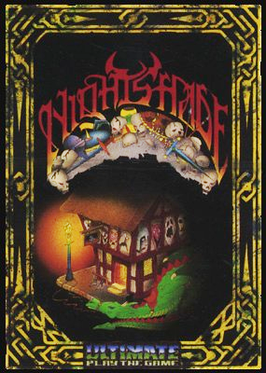
Nightshade is an action video game developed and published by Ultimate Play the Game. It was first released for the ZX Spectrum in 1985, and was then ported to the Amstrad CPC and BBC Micro later that year. It was also ported to the MSX exclusively in Japan in 1986. In the game, the player assumes the role of a knight who sets out to destroy four demons in a plague-infested village.

Tass Times in Tonetown is an adventure game published by Activision in 1986. It was designed by Michael Berlyn and Muffy McClung Berlyn and programmed by Rebecca Heineman of Interplay in cooperation with Brainwave Creations.
MacVenture is a series of four adventure games with a menu-based point-and-click interface. They were originally developed for the Macintosh by ICOM Simulations:
- Déjà Vu (1985)
- Uninvited (1986)
- Shadowgate (1987)
- Deja Vu II: Lost in Las Vegas (1988)

Blazing Dragons is a point-and-click adventure game developed by the Illusions Gaming Company and published by Crystal Dynamics. It is based on the television series of the same name and was released for the PlayStation and Sega Saturn in late 1996.

Shadowkeep is a first person role-playing video game and interactive fiction video game with graphics. The game was published by Telarium, a subsidiary of Spinnaker Software, in the year 1984. It was the first computer game to be novelised.
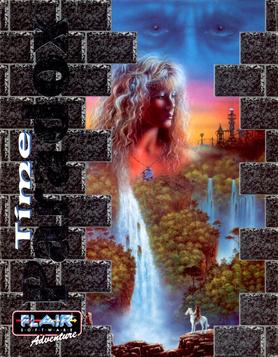
Time Paradox is a point-and-click adventure game developed and released by Flair Software for the MS-DOS in 1996 only in Europe.

The Legend of Kyrandia: Book One is a 2D point-and-click adventure game, developed by Westwood Studios and published by Virgin Games in August 1992. The game is the first in the The Legend of Kyrandia series, and focuses on players taking on the role of a young prince who put an end to the tyrannical chaos of an evil court jester.
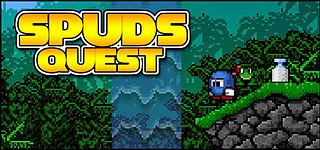
Spud's Quest is an independent adventure platformer video game for the Microsoft Windows that draws its inspiration from the classic games of yesteryear, most notably the Dizzy, The Legend of Zelda, Tomb Raider and Metroid series. This is the first game developed by Mouldy Toof Studios, a Chris Davis' one man studio. It was made with Clickteam Fusion 2.5 (CF2.5), a video game creation tool.



















